Abstract
A growing number of studies show an association between attention deficit hyperactivity disorder and physical abuse in childhood. We examined temporal associations of physical abuse risk with methylphenidate treatment in children with attention deficit hyperactivity disorder. Using Hong Kong electronic medical records, we conducted a self-controlled case series study in 1,064 children (5–16 years old) who were treated with methylphenidate and also experienced physical abuse. Compared with non-medicated periods, a higher risk of abuse was observed shortly before treatment initiation (incidence rate ratio = 4.49; 95% confidence interval = 3.76–5.36). After treatment initiation, the risk was comparable to that in non-medicated periods (incidence rate ratio = 0.90; 95% confidence interval = 0.63–1.29), followed by a 37% reduction during subsequent treatment. These findings are consistent with the hypothesis that methylphenidate treatment in children with attention deficit hyperactivity disorder is associated with a reduced risk of becoming a victim of physical abuse.
This is a preview of subscription content, access via your institution
Access options
Subscribe to this journal
Receive 12 digital issues and online access to articles
79,00 € per year
only 6,58 € per issue
Buy this article
- Purchase on SpringerLink
- Instant access to full article PDF
Prices may be subject to local taxes which are calculated during checkout




Similar content being viewed by others
Data availability
Data cannot be shared as the data custodian—Hong Kong Hospital Authority—did not give permission due to patient confidentiality and privacy concerns. According to the conditions laid down by Hong Kong Hospital Authority, only local academic institutions, government departments or non-governmental organizations may apply for access to data through the Hospital Authority data sharing portal (https://www3.ha.org.hk/data).
Code availability
All relevant analysis codes are available online (https://github.com/legao513/child-abuse).
References
WHO Global Status Report on Violence Prevention 2014 (WHO Media Centre, 2014); https://www.who.int/publications/i/item/9789241564793
WHO Fact Sheet on Child Maltreatment (WHO Media Centre, 2022); https://www.who.int/news-room/fact-sheets/detail/child-maltreatment
Arango, C. et al. Risk and protective factors for mental disorders beyond genetics: an evidence-based atlas. World Psychiatry 20, 417–436 (2021).
Ip, P. et al. Child maltreatment hospitalisations in Hong Kong: incidence rate and seasonal pattern. Arch. Dis. Child. 101, 1107–1113 (2016).
Mandell, D. S., Walrath, C. M., Manteuffel, B., Sgro, G. & Pinto-Martin, J. A. The prevalence and correlates of abuse among children with autism served in comprehensive community-based mental health settings. Child Abus. Negl. 29, 1359–1372 (2005).
Hadianfard, H. Child abuse in group of children with attention deficit–hyperactivity disorder in comparison with normal children. Int. J. Community Based Nurs. Midwifery 2, 77–84 (2014).
Ford, J. D. et al. Child maltreatment, other trauma exposure, and posttraumatic symptomatology among children with oppositional defiant and attention deficit hyperactivity disorders. Child Maltreat. 5, 205–217 (2000).
Sari Gokten, E., Saday Duman, N., Soylu, N. & Uzun, M. E. Effects of attention-deficit/hyperactivity disorder on child abuse and neglect. Child Abus. Negl. 62, 1–9 (2016).
Schilling, S. & Christian, C. W. Child physical abuse and neglect. Child Adolesc. Psychiatr. Clin. N. Am. 23, 309–319 (2014).
Faraone, S. V. et al. The World Federation of ADHD International Consensus Statement: 208 evidence-based conclusions about the disorder. Neurosci. Biobehav. Rev. 128, 789–818 (2021).
Demontis, D. et al. Discovery of the first genome-wide significant risk loci for attention deficit/hyperactivity disorder. Nat. Genet. 51, 63–75 (2019).
Leitch, S. et al. Experience of stress in parents of children with ADHD: a qualitative study. Int. J. Qual. Stud. Health Well-being 14, 1690091 (2019).
Dykens, E. M. Family adjustment and interventions in neurodevelopmental disorders. Curr. Opin. Psychiatry 28, 121–126 (2015).
Brockington, I. et al. WPA guidance on the protection and promotion of mental health in children of persons with severe mental disorders. World Psychiatry 10, 93–102 (2011).
Coates, J., Taylor, J. A. & Sayal, K. Parenting interventions for ADHD: a systematic literature review and meta-analysis. J. Atten. Disord. 19, 831–843 (2015).
Lo, H. H. M. et al. The effects of family-based mindfulness intervention on ADHD symptomology in young children and their parents: a randomized control trial. J. Atten. Disord. 24, 667–680 (2020).
DuPaul, G. J., Gormley, M. J. & Laracy, S. D. School-based interventions for elementary school students with ADHD. Child Adolesc. Psychiatr. Clin. N. Am. 23, 687–697 (2014).
Power, T. J. et al. A family–school intervention for children with ADHD: results of a randomized clinical trial. J. Consult. Clin. Psychol. 80, 611–623 (2012).
Epstein, J. N. et al. Impact of a web-portal intervention on community ADHD care and outcomes. Pediatrics 138, e20154240 (2016).
Au, A. et al. The efficacy of a group Triple P (Positive Parenting Program) for Chinese parents with a child diagnosed with ADHD in Hong Kong: a pilot randomised controlled study. Aust. Psychol. 49, 151–162 (2014).
Wong, W. C. & Wong, I. Y. F. Burden and coping strategies of parents of children with attention deficit/ hyperactivity disorder in Hong Kong: a qualitative study. Nurs. Open 8, 3452–3460 (2021).
Crandell, J. L., Sandelowski, M., Leeman, J., Havill, N. L. & Knafl, K. Parenting behaviors and the well-being of children with a chronic physical condition. Fam. Syst. Health 36, 45–61 (2018).
Tamura, K., Morrison, J. & Pikhart, H. Children’s behavioural problems and its associations with socioeconomic position and early parenting environment: findings from the UK Millennium Cohort Study. Epidemiol. Psychiatr. Sci. 29, e155 (2020).
Pfiffner, L. J. & Haack, L. M. Behavior management for school-aged children with ADHD. Child Adolesc. Psychiatr. Clin. N. Am. 23, 731–746 (2014).
Cortese, S. Pharmacologic treatment of attention deficit–hyperactivity disorder. N. Engl. J. Med. 383, 1050–1056 (2020).
Cortese, S. et al. Starting ADHD medications during the COVID-19 pandemic: recommendations from the European ADHD Guidelines Group. Lancet Child Adolesc. Health 4, e15 (2020).
Man, K. K. et al. Methylphenidate and the risk of trauma. Pediatrics 135, 40–48 (2015).
Man, K. K. C. et al. Effectiveness of pharmacological treatment for attention-deficit/hyperactivity disorder on physical injuries: a systematic review and meta-analysis of observational studies. CNS Drugs 31, 1043–1055 (2017).
Ghirardi, L. et al. Use of medication for attention-deficit/hyperactivity disorder and risk of unintentional injuries in children and adolescents with co-occurring neurodevelopmental disorders. J. Child Psychol. Psychiatry 61, 140–147 (2020).
Solmi, M. et al. Safety of 80 antidepressants, antipsychotics, anti-attention-deficit/hyperactivity medications and mood stabilizers in children and adolescents with psychiatric disorders: a large scale systematic meta-review of 78 adverse effects. World Psychiatry 19, 214–232 (2020).
Cortese, S. et al. Comparative efficacy and tolerability of medications for attention-deficit hyperactivity disorder in children, adolescents, and adults: a systematic review and network meta-analysis. Lancet Psychiatry 5, 727–738 (2018).
Correll, C. U. et al. Efficacy and acceptability of pharmacological, psychosocial, and brain stimulation interventions in children and adolescents with mental disorders: an umbrella review. World Psychiatry 20, 244–275 (2021).
Levi-Shachar, O. et al. The effect of methylphenidate on social cognition and oxytocin in children with attention deficit hyperactivity disorder. Neuropsychopharmacology 45, 367–373 (2020).
Raman, S. R. et al. Trends in attention-deficit hyperactivity disorder medication use: a retrospective observational study using population-based databases. Lancet Psychiatry 5, 824–835 (2018).
Graziano, P. A., McNamara, J. P., Geffken, G. R. & Reid, A. Severity of children’s ADHD symptoms and parenting stress: a multiple mediation model of self-regulation. J. Abnorm. Child Psychol. 39, 1073–1083 (2011).
Theule, J., Wiener, J., Tannock, R. & Jenkins, J. M. Parenting stress in families of children with ADHD: a meta-analysis. J. Emot. Behav. Disord. 21, 3–17 (2013).
Ciesielski, H. A., Loren, R. E. A. & Tamm, L. Behavioral parent training for ADHD reduces situational severity of child noncompliance and related parental stress. J. Atten. Disord. 24, 758–767 (2020).
Larsen, L. B. et al. Effect of parent training on health-related quality of life in preschool children with attention-deficit/hyperactivity disorder: a secondary analysis of data from a randomized controlled trial. J. Am. Acad. Child Adolesc. Psychiatry 60, 734–744 e733 (2021).
Mah, J. W. T., Murray, C., Locke, J. & Carbert, N. Mindfulness-enhanced behavioral parent training for clinic-referred families of children with ADHD: a randomized controlled trial. J. Atten. Disord. 25, 1765–1777 (2021).
Zwi, M., Jones, H., Thorgaard, C., York, A. & Dennis, J. A. Parent training interventions for Attention Deficit Hyperactivity Disorder (ADHD) in children aged 5 to 18 years. Cochrane Database Syst. Rev. 12, CD003018 (2011).
Cheung, K. K. et al. Experiences of adolescents and young adults with ADHD in Hong Kong: treatment services and clinical management. BMC Psychiatry 15, 95 (2015).
Lai, K. Y. C., Ma, J. L. C. & Xia, L. L. L. Multifamily therapy for children with ADHD in Hong Kong: the different impacts on fathers and mothers. J. Atten. Disord. 25, 115–123 (2021).
Ma, J. L. C., Lai, K. Y. C. & Xia, L. L. L. Treatment efficacy of multiple family therapy for Chinese families of children with attention deficit hyperactivity disorder. Fam. Process 57, 399–414 (2018).
Lin, Y. C. et al. Stimulants associated with reduced risk of hospitalization for motor vehicle accident injury in patients with obstructive sleep apnea—a nationwide cohort study. BMC Pulm. Med. 20, 28 (2020).
Liao, Y. T. et al. Dosage of methylphenidate and traumatic brain injury in ADHD: a population-based study in Taiwan. Eur. Child Adolesc. Psychiatry 27, 279–288 (2018).
Chang, Z. et al. Stimulant ADHD medication and risk for substance abuse. J. Child Psychol. Psychiatry 55, 878–885 (2014).
Lichtenstein, P. et al. Medication for attention deficit—hyperactivity disorder and criminality. N. Engl. J. Med. 367, 2006–2014 (2012).
Boland, H. et al. A literature review and meta-analysis on the effects of ADHD medications on functional outcomes. J. Psychiatr. Res. 123, 21–30 (2020).
Buitelaar, J. K. et al. Long-term methylphenidate exposure and 24-hours blood pressure and left ventricular mass in adolescents and young adults with attention deficit hyperactivity disorder. Eur. Neuropsychopharmacol. 64, 63–71 (2022).
Hennissen, L. et al. Cardiovascular effects of stimulant and non-stimulant medication for children and adolescents with ADHD: a systematic review and meta-analysis of trials of methylphenidate, amphetamines and atomoxetine. CNS Drugs 31, 199–215 (2017).
Carucci, S. et al. Long term methylphenidate exposure and growth in children and adolescents with ADHD. A systematic review and meta-analysis. Neurosci. Biobehav. Rev. 120, 509–525 (2021).
Coghill, D. et al. The management of ADHD in children and adolescents: bringing evidence to the clinic: perspective from the European ADHD Guidelines Group (EAGG). Eur. Child Adolesc. Psychiatry https://doi.org/10.1007/s00787-021-01871-x (2021).
Man, K. K. C. et al. Methylphenidate and the risk of psychotic disorders and hallucinations in children and adolescents in a large health system. Transl. Psychiatry 6, e956 (2016).
Man, K. K. C. et al. Association of risk of suicide attempts with methylphenidate treatment. JAMA Psychiatry 74, 1048–1055 (2017).
Leung, G. M. et al. The ecology of health care in Hong Kong. Soc. Sci. Med. 61, 577–590 (2005).
Lau, W. C. Y. et al. Association between treatment with apixaban, dabigatran, rivaroxaban, or warfarin and risk for osteoporotic fractures among patients with atrial fibrillation: a population-based cohort study. Ann. Intern. Med. 173, 1–9 (2020).
Man, K. K. C. et al. Association between methylphenidate treatment and risk of seizure: a population-based, self-controlled case-series study. Lancet Child Adolesc. Health 4, 435–443 (2020).
HAHO/ITD Clinical Data Analysis & Reporting System (CDARS) User’s Manual 3 (Hong Kong, 2003).
Whitaker, H. J., Farrington, C. P., Spiessens, B. & Musonda, P. Tutorial in biostatistics: the self-controlled case series method. Stat. Med. 25, 1768–1797 (2006).
Petersen, I., Douglas, I. & Whitaker, H. Self controlled case series methods: an alternative to standard epidemiological study designs. Br. Med. J. 354, i4515 (2016).
Suhail, K. & Cochrane, R. Seasonal variations in hospital admissions for affective disorders by gender and ethnicity. Soc. Psychiatry Psychiatr. Epidemiol. 33, 211–217 (1998).
Hale, T. et al. A global panel database of pandemic policies (Oxford COVID-19 Government Response Tracker). Nat. Hum. Behav. 5, 529–538 (2021).
Chang, Z. et al. Risks and benefits of attention-deficit/hyperactivity disorder medication on behavioral and neuropsychiatric outcomes: a qualitative review of pharmacoepidemiology studies using linked prescription databases. Biol. Psychiatry 86, 335–343 (2019).
Protecting Children from Maltreatment—Procedural Guide for Multi-disciplinary Co-operation (Revised 2020) (Social Welfare Department of the Hong Kong Government, 2020); https://www.swd.gov.hk/en/index/site_pubsvc/page_family/sub_fcwprocedure/id_1447/
Longstreth, W. T. Jr., Koepsell, T. D., Ton, T. G., Hendrickson, A. F. & van Belle, G. The epidemiology of narcolepsy. Sleep 30, 13–26 (2007).
Lo, C. K. et al. Linking healthcare and social service databases to study the epidemiology of child maltreatment and associated health problems: Hong Kong’s experience. J. Pediatr. 202, 291–299.e1 (2018).
Lo, C. K. M. et al. Prevalence of child maltreatment and its association with parenting style: a population study in Hong Kong. Int. J. Environ. Res. Public Health 16, 1130 (2019).
National Guideline Centre (UK) Attention Deficit Hyperactivity Disorder: Diagnosis and Management (National Institute for Health and Care Excellence, 2018).
VanderWeele, T. J. & Ding, P. Sensitivity analysis in observational research: introducing the E-value. Ann. Intern. Med. 167, 268–274 (2017).
Musonda, P., Farrington, C. P. & Whitaker, H. J. Sample sizes for self-controlled case series studies. Stat. Med. 25, 2618–2631 (2006).
Acknowledgements
This study is funded by the Hong Kong Research Grant Council Collaborative Research Fund (grant number C7009-19GF). The funders had no role in study design, data collection and analysis, decision to publish or preparation of the manuscript. We also thank L. Lam for proofreading the manuscript and acknowledge the support from European Commission Framework Horizon 2020 funding.
Author information
Authors and Affiliations
Contributions
K.K.C.M., L.G., P.I. and I.C.K.W. designed the study. K.K.C.M., L.G., W.C.Y.L. and M.F. extracted the data, conducted the statistical analyses and cross-checked the analyses. K.K.C.M. and L.G. wrote the first draft of the manuscript. D.C. and P.I. provided critical input to the interpretation of the analyses. P.I. and I.C.K.W. are the principal investigators, providing resources and supervising all aspects of the project. All authors contributed to the interpretation of the analyses and the review and editing of the manuscript, and approved the submission of the final version.
Corresponding authors
Ethics declarations
Competing interests
K.K.C.M. is the recipient of the CW Maplethorpe Fellowship, and reports grants from the National Institute for Health Research, UK, the European Commission Horizon 2020 Framework, EU, and the Research Grant Council, Hong Kong, and personal fees from IQVIA Ltd., unrelated to the submitted work. W.C.Y.L. reports a research grant from AIR@InnoHK administered by the Innovation and Technology Commission outside the submitted work. D.C. reports personal fees from Shire/Takeda, personal fees from Medice, personal fees from Servier and personal fees from Oxford University Press, outside the submitted work. E.W.C. reports grants from the Research Grants Council (RGC, Hong Kong), grants from the Narcotics Division of the Security Bureau of the Government of the Hong Kong SAR, grants from the Research Fund Secretariat of the Food and Health Bureau, grants from the National Natural Science Fund of China, grants from the National Health and Medical Research Council (NHMRC, Australia), grants from Wellcome Trust, grants from Bayer, grants from Bristol-Myers Squibb, grants from Pfizer, grants from Janssen, grants from Amgen, grants from Takeda and personal fees from Hospital Authority of Hong Kong, outside the submitted work. X.L. received grants from the Health and Medical Research Fund, Food and Health Bureau of the Government of Hong Kong, the Research Grants Council Early Career Scheme (RGC/ECS), Janssen, Pfizer, internal funding from the University of Hong Kong and a consultancy fee from Merck Sharp & Dohme and Pfizer, unrelated to this work. A.Y.L.C. reports a grant from the Innovation and Technology Commission of the Hong Kong Special Administration Region Government for salary at the University of Hong Kong. Y.K.W. reports grants from the Research Grant Council General Research Fund, grants from the Health and Medical Research Fund, personal fees from Eisai Inc., personal fees from Eisai Co., Ltd, and other fees from Lundbeck HK Limited, outside the submitted work. I.C.K.W. reports research funding outside the submitted work from Amgen, Bristol-Myers Squibb, Pfizer, Janssen, Bayer, GSK, Novartis, the Hong Kong RGC, the Hong Kong Health and Medical Research Fund, the National Institute for Health Research in England, the European Commission and the National Health and Medical Research Council in Australia, and also received speaker fees from Janssen and Medice in the previous 3 years. All other authors declare no competing interests.
Peer review
Peer review information
Nature Mental Health thanks the anonymous reviewers for their contribution to the peer review of this work.
Additional information
Publisher’s note Springer Nature remains neutral with regard to jurisdictional claims in published maps and institutional affiliations.
Extended data
Extended Data Fig. 1
Histogram of age at the incident physical abuse.
Extended Data Fig. 2 Time from the first physical abuse case to MPH initiation.
Abbreviation: MPH, methylphenidate.
Supplementary information
Supplementary Information
Supplementary Tables 1–4, Discussion, Notes 1 and 2 and equation.
Rights and permissions
Springer Nature or its licensor (e.g. a society or other partner) holds exclusive rights to this article under a publishing agreement with the author(s) or other rightsholder(s); author self-archiving of the accepted manuscript version of this article is solely governed by the terms of such publishing agreement and applicable law.
About this article
Cite this article
Man, K.K.C., Gao, L., Lau, W.C.Y. et al. Attention deficit hyperactivity disorder, physical abuse and methylphenidate treatment in children. Nat. Mental Health 1, 66–75 (2023). https://doi.org/10.1038/s44220-022-00008-6
Received:
Accepted:
Published:
Issue Date:
DOI: https://doi.org/10.1038/s44220-022-00008-6



